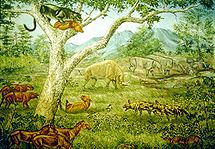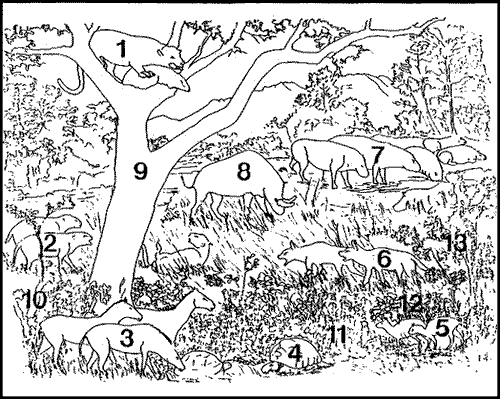
Mesocyon
Encyclopedia
Mesocyon is an extinct genus
of terrestrial
carnivore
within the family
Canidae
, subfamily Hesperocyoninae
, which inhabited North America
from the Early Oligocene 33.9—20.6 Ma, existing for approximately .
Though a carnivore, dentition suggests this animal was a hypercarnivore
or mesocarnivore
.
member of a clade
that also includes the genera Cynodesmus
, Sunkahetanka
, Philotrox
, and Enhydrocyon
. Mesocyon was named by Scott (1890). It was synonymized subjectively with Enhydrocyon by Swisher (1982). It was assigned to Canidae by Scott (1890), Carroll (1988) and Stevens (1991).
Colorado
, southern Wyoming
, and western Nebraska
.
Genus
In biology, a genus is a low-level taxonomic rank used in the biological classification of living and fossil organisms, which is an example of definition by genus and differentia...
of terrestrial
Terrestrial animal
Terrestrial animals are animals that live predominantly or entirely on land , as compared with aquatic animals, which live predominantly or entirely in the water , or amphibians, which rely on a combination of aquatic and terrestrial habitats...
carnivore
Carnivore
A carnivore meaning 'meat eater' is an organism that derives its energy and nutrient requirements from a diet consisting mainly or exclusively of animal tissue, whether through predation or scavenging...
within the family
Family (biology)
In biological classification, family is* a taxonomic rank. Other well-known ranks are life, domain, kingdom, phylum, class, order, genus, and species, with family fitting between order and genus. As for the other well-known ranks, there is the option of an immediately lower rank, indicated by the...
Canidae
Canidae
Canidae is the biological family of carnivorous and omnivorous mammals that includes wolves, foxes, jackals, coyotes, and domestic dogs. A member of this family is called a canid . The Canidae family is divided into two tribes: Canini and Vulpini...
, subfamily Hesperocyoninae
Hesperocyoninae
Hesperocyoninae is a subfamily of extinct canids.-Taxonomic history:Hesperocyoninae was named by Martin . The members of this subfamily were reassigned to the family Canidae by Xiaoming Wang in 1999....
, which inhabited North America
North America
North America is a continent wholly within the Northern Hemisphere and almost wholly within the Western Hemisphere. It is also considered a northern subcontinent of the Americas...
from the Early Oligocene 33.9—20.6 Ma, existing for approximately .
Though a carnivore, dentition suggests this animal was a hypercarnivore
Hypercarnivore
A hypercarnivore is an animal which has a diet that is more than 70% meat, with the balance consisting of non-animal foods such as fungi, fruits or other plant material. Some examples include the big cats, dolphins, eagles, snakes, marlin, most sharks, and such invertebrates as octopuses and sea...
or mesocarnivore
Mesocarnivore
A mesocarnivore is an animal whose diet consists of 50–70% meat with the balance consisting of nonvertebrate foods which may include fungi, fruits, and other plant material...
.
Taxonomy
Mesocyon was the most basalBasal (phylogenetics)
In phylogenetics, a basal clade is the earliest clade to branch in a larger clade; it appears at the base of a cladogram.A basal group forms an outgroup to the rest of the clade, such as in the following example:...
member of a clade
Clade
A clade is a group consisting of a species and all its descendants. In the terms of biological systematics, a clade is a single "branch" on the "tree of life". The idea that such a "natural group" of organisms should be grouped together and given a taxonomic name is central to biological...
that also includes the genera Cynodesmus
Cynodesmus
Cynodesmus is an extinct genus of omnivorous canine which inhabited North America during the Oligocene living from 33.3—-26.3 Ma and existed for approximately ....
, Sunkahetanka
Sunkahetanka
Sunkahetanka is an extinct genus of small bone crushing omnivorous mammal similar to a dog of the family Canidae) which inhabited North America during the Oligocene living from 30.8—26.3 Ma and existed for approximately .-Taxonomy:...
, Philotrox
Philotrox
Philotrox is an extinct genus of bone crushing omnivorous mammal similar to a dog of the family Canidae) which inhabited North America during the Oligocene living from 30.8—26.3 Ma and existed for approximately .-Taxonomy:...
, and Enhydrocyon
Enhydrocyon
Enhydrocyon is an extinct genus of bone crushing dog which inhabited North America exclusively during the Oligocene living from around 28.7—22.0 Ma and existed for approximately ....
. Mesocyon was named by Scott (1890). It was synonymized subjectively with Enhydrocyon by Swisher (1982). It was assigned to Canidae by Scott (1890), Carroll (1988) and Stevens (1991).
Morphology
Two specimens were examined by Legendre and Roth with the first specimen's mass being estimated at 7.4 kg (16.3 lbs). The second specimen's mass was estimated at 7.19 kg (15.8 lbs).Fossil distribution
Fossils were uncovered on 2 sites in north central Oregon. Also, 10 other sites from southern CaliforniaCalifornia
California is a state located on the West Coast of the United States. It is by far the most populous U.S. state, and the third-largest by land area...
Colorado
Colorado
Colorado is a U.S. state that encompasses much of the Rocky Mountains as well as the northeastern portion of the Colorado Plateau and the western edge of the Great Plains...
, southern Wyoming
Wyoming
Wyoming is a state in the mountain region of the Western United States. The western two thirds of the state is covered mostly with the mountain ranges and rangelands in the foothills of the Eastern Rocky Mountains, while the eastern third of the state is high elevation prairie known as the High...
, and western Nebraska
Nebraska
Nebraska is a state on the Great Plains of the Midwestern United States. The state's capital is Lincoln and its largest city is Omaha, on the Missouri River....
.
 |  |

